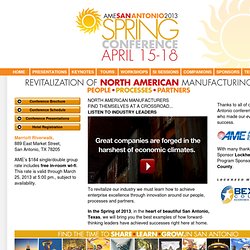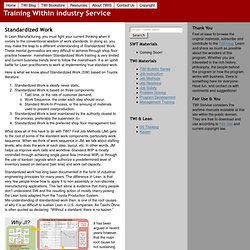

Association for Manufacturing Excellence. Assess Costs Everywhere. AME Spring Conference 2013 - Lean Conference - AME. North American manufacturers find themselves at a crossroad...Listen to Industry Leaders To revitalize our industry we must learn how to achieve enterprise excellence through innovation around our people, processes and partners.

In the Spring of 2013, in the heart of beautiful San Antonio, Texas, we will bring you the best examples of how forward-thinking leaders have achieved successes right here at home. Thanks to all of our San Antonio conference attendees who made our event a great success. With many thanks to our Silver Sponsor Lockheed Martin and Program Sponsor Bexar County. AME Spring 2013 Home.
Lean Concepts / Philosophy. Leading, Learning, Innovation with Toyota Kata. Lean Flow / 3M Waste. Kaizen. Kaizen (改善?)

, Japanese for "improvement" or "change for the best", refers to philosophy or practices that focus upon continuous improvement of processes in manufacturing, engineering, business management or any process. It has been applied in healthcare,[1] psychotherapy,[2] life-coaching, government, banking, and other industries. When used in the business sense and applied to the workplace, kaizen refers to activities that continually improve all functions, and involves all employees from the CEO to the assembly line workers. It also applies to processes, such as purchasing and logistics, that cross organizational boundaries into the supply chain.[3] By improving standardized activities and processes, kaizen aims to eliminate waste (see lean manufacturing). Kaizen was first implemented in several Japanese businesses after the Second World War, influenced in part by American business and quality management teachers who visited the country.
Overview[edit] History[edit] See also[edit] Standardized Work - Training Within Industry Service - TWI Original Manuals. In Lean Manufacturing, you must fight your current thinking when it comes to the conventional wisdom of work standards.

In doing so, you may make the leap to a different understanding of Standardized Work. These mental gymnastics are very difficult to achieve through shop floor practice however; mainstream Standardized Work training is very limited and current business trends tend to follow the mainstream. It is an uphill battle for Lean practitioners to work at implementing true standard work. Here is what we know about Standardized Work (SW) based on Toyota literature: Standardized Work is ideally never static, Standardized Work is based on three components: Takt time, or the rate of customer demand, Work Sequence, the order each step should occur, Standard Work-In-Process, or the amoung of materials used to prevent overproduction. What does all of this have to do with TWI? Standardized work has long been documented in the form of industrial engineering principles for many years.
TWI. Training Within Industry Service - TWI Instruction Manuals.
Lean manufacturing. Overview[edit] The difference between these two approaches is not the goal itself, but rather the prime approach to achieving it.

The implementation of smooth flow exposes quality problems that already existed, and thus waste reduction naturally happens as a consequence. The advantage claimed for this approach is that it naturally takes a system-wide perspective, whereas a waste focus sometimes wrongly assumes this perspective. Both lean and TPS can be seen as a loosely connected set of potentially competing principles whose goal is cost reduction by the elimination of waste.[5] These principles include: Pull processing, Perfect first-time quality, Waste minimization, Continuous improvement, Flexibility, Building and maintaining a long term relationship with suppliers, Autonomation, Load leveling and Production flow and Visual control.
Origins[edit] Lean aims to make the work simple enough to understand, do and manage. A brief history of waste reduction thinking[edit] 20th century[edit]